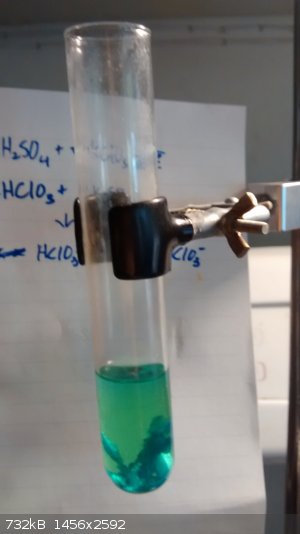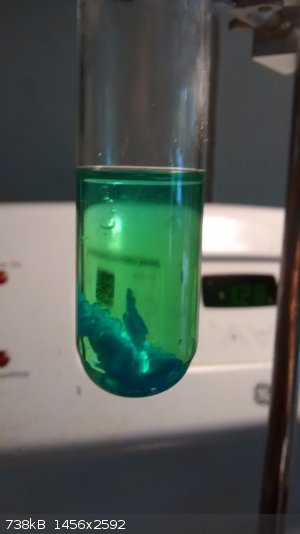Zyklon-A
International Hazard
    
Posts: 1547
Registered: 26-11-2013
Member Is Offline
Mood: Fluorine radical
|
|
Copper chlorate?
I was experimenting with dissolving copper in acids with various oxidizing agents.
Among them, I tried sulfuric acid with dissolved KClO3.
First I diluted sulfuric acid to about 50-60% concentration.
I took about 20 mLs of this solution and added 2 grams of KClO3, which dissolved completely due to the rather high temperature. An
equilibrium of sulfuric and chloric acid should then exsist in the solution:
H2SO4 + KClO3 (--) HClO3 + .5 K2SO4.
I added probably less than a gram of copper metal (I should've weighed it) and promptly gasses were evolved.
I quickly smelled chlorine, which I decided was likely from the decomposition of chloric acid.
The solution became a light green color, which got darker and darker for the next three hours, until all the copper dissolved.
A day later strange but beautiful green crystals had grown. I have not yet touched anything yet because I don't know how stable the products are.
I assume the crysals are copper (II) chlorate •2.6 H2O.
Please correct me if I'm wrong, and all comments are welcome.
Has anyone tried this or anything similar?
[EDIT] TYPO, I'LL try to upload a picture as soon as possible.
[Edited on 2-8-2014 by Zyklon-A]
|
|
|
arkoma
Redneck Overlord
      
Posts: 1761
Registered: 3-2-2014
Location: On a Big Blue Marble hurtling through space
Member Is Offline
Mood: украї́нська
|
|
I love copper salts. Picture maybe Zyklon?
"We believe the knowledge and cultural heritage of mankind should be accessible to all people around the world, regardless of their wealth, social
status, nationality, citizenship, etc" z-lib
|
|
|
Zyklon-A
International Hazard
    
Posts: 1547
Registered: 26-11-2013
Member Is Offline
Mood: Fluorine radical
|
|
Sure, again, I haven't taken them out of the test tube for fear of them being unstable.
Not great quality but you get the idea, they look fimilar to me, I just don't remember what...
 
|
|
|
cyanureeves
National Hazard
   
Posts: 737
Registered: 29-8-2010
Location: Mars
Member Is Offline
Mood: No Mood
|
|
very interesting and pretty and pretty interesting too! if it doesnt explode when dried or deflagrate under heat maybe IT will bjrn with sugar.maybe
its as stable as potassium chlorate or maybe you now have copper sulfate in a chlorinated solution or vice versa,copper chloride in a sulphuric
solution.maybe you have copper chlorate.
|
|
|
Zyklon-A
International Hazard
    
Posts: 1547
Registered: 26-11-2013
Member Is Offline
Mood: Fluorine radical
|
|
Perhaps, perhaps, perhaps...
Well, I [carefully] took the crystals out of the solution, and to be honest, in color they look like copper sulfate, but the geometry of them looks
different. Copper sulfate crystals seem to have a different shape.
I did a hammer test with a small piece, nothing happened at all, so it is definitely stable to shock and friction [sigh].
I haven't yet tested whether it will accelerate the combustion of organic substances, but that seems like a good idea.
|
|
|
PHILOU Zrealone
International Hazard
    
Posts: 2893
Registered: 20-5-2002
Location: Brussel
Member Is Offline
Mood: Bis-diazo-dinitro-hydroquinonic
|
|
HClO3 is usually unstable over 35% and over that % free ClO2 what smells like chlorine, has the same colour but is highly explosive from small organic
traces...this is why chlorate salt pyrotechnic powders are kept away from sulfur (it contains small traces of H2SO4 or oxydises from air and forms
traces of SO3).
This is how conc H2SO4 can burst KClO3/Suggar mix into flame from simple contact.
H2SO4 will react with copper to form CuSO4 and SO2(g).
SO2 will then be oxydised by the HClO3 or ClO2 to form SO3 and Cl2 or Cl(-).
SO3 will react with water to form H2SO4 again.
Cl(-) reacts with HClO3 to produce Cl2 and H2O.
So your cristals are likely CuSO4 maybe a in a mix with KHSO4 or K2SO4: the liquid contains probably some CuCl2 because of the green color of it.
Cu(ClO3)2 is extremely soluble in water! To get it is best to work from plain HClO3 (made from Ba(ClO3)2 or Ca(ClO3)2 and H2SO4 in stoechiometric
amount) and allow it to react with Cu(OH)2 or CuO.
PH Z (PHILOU Zrealone)
"Physic is all what never works; Chemistry is all what stinks and explodes!"-"Life that deadly disease, sexually transmitted."(W.Allen)
|
|
|
AJKOER
Radically Dubious
    
Posts: 3026
Registered: 7-5-2011
Member Is Offline
Mood: No Mood
|
|
Quote: Originally posted by PHILOU Zrealone  | ......
Cu(ClO3)2 is extremely soluble in water! To get it is best to work from plain HClO3 (made from Ba(ClO3)2 or Ca(ClO3)2 and H2SO4 in stoechiometric
amount) and allow it to react with Cu(OH)2 or CuO. |
Here is the comment on its preparation per Atomistry.com http://copper.atomistry.com/cupric_chlorate.html which is in agreement with the above. To quote:
"Cupric chlorate, Cu(ClO3)2, is prepared by dissolving cupric hydroxide or carbonate in chloric acid, or by the interaction of cupric sulphate and
barium chlorate. On evaporation of the solution it separates in the form of the tetrahydrate, which melts and decomposes at 73° C."
Chloric acid an be also prepared by the action of Oxalic acid, H2C2O4, on nearly any available chlorate:
H2C2O4 + 2 KClO3 -----) K2C2O4(s) + 2 HClO3
One must avoid an excess of Oxalic acid as it will reduce the newly formed HClO3 yielding potentially explosive ClO2 gas diluted with CO2. In fact,
the latter is a preparation path to ClO2, upon employing an excess Oxalic acid:
2 HClO3 + H2C2O4 --> 2 ClO2 + 2 H2O + 2 CO2
so the net reaction would be:
2 KClO3 + 2 H2C2O4 --> 2 ClO2 (g) + 2 H2O + 2 CO2 (g) + K2C2O4 (s)
See http://books.google.com/books?id=6wUmteTIc18C&pg=PA334&a...
Preparing HClO3 from KCl03 and H2S04 is dangerous and not advise. However, one can drip concentrated H2SO4 on a mixture of sugar and KClO3, which
releases vapors of HClO3 (see http://en.m.wikipedia.org/wiki/HClO3 ).
[Edited on 3-8-2014 by AJKOER]
|
|
|
Metacelsus
International Hazard
    
Posts: 2531
Registered: 26-12-2012
Location: Boston, MA
Member Is Offline
Mood: Double, double, toil and trouble
|
|
Quote: Originally posted by AJKOER  |
Preparing HClO3 from KCl03 and H2S04 is dangerous and not advise. However, one can drip concentrated H2SO4 on a mixture of sugar and KClO3, which
releases vapors of HClO3.
|
. . . which then reacts with the sugar and starts a fire. Don't try this if you want chloric acid.
The barium chlorate and copper sulfate method is probably the easiest and safest, as it avoids chloric acid.
|
|
|
Brain&Force
Hazard to Lanthanides
    
Posts: 1302
Registered: 13-11-2013
Location: UW-Madison
Member Is Offline
Mood: Incommensurately modulated
|
|
Cheddite's method is the simplest if barium chlorate is available.
If you're daring enough you can also create the tetraamminecopper(II) chlorate salt, which is quite energetic. Or you could add the copper chlorate to
the campfire and color it green.
woelen also did work on copper(II) perchlorate and its ethylenediamine complexes: http://woelen.homescience.net/science/chem/exps/Ni_en_comple...
At the end of the day, simulating atoms doesn't beat working with the real things...
|
|
|
Metacelsus
International Hazard
    
Posts: 2531
Registered: 26-12-2012
Location: Boston, MA
Member Is Offline
Mood: Double, double, toil and trouble
|
|
If you just want to do pyrotechnic stuff, copper perchlorate is better (and easier to make, as perchloric acid is stable).
|
|
|
Zyklon-A
International Hazard
    
Posts: 1547
Registered: 26-11-2013
Member Is Offline
Mood: Fluorine radical
|
|
I think PHILOU Zrealone is right about them being copper sulfate, I had mistaken them for green due to the color of the solution,
they were in fact the nice blue color of sulfate when I took them out.
| Quote: |
Preparing HClO3 from KCl03 and H2S04 is dangerous and not advise. |
Which is why I did it in a dilute solution, I am very aware of the explosive properties of chlorates and conc. sulfuric acid.
| Quote: |
If you just want to do pyrotechnic stuff, copper perchlorate is better (and easier to make, as perchloric acid is stable). |
Is it easy to get out of solution?
I'm not really interested in pyrotechnics either way.
[Edited on 4-8-2014 by Zyklon-A]
|
|
|
PHILOU Zrealone
International Hazard
    
Posts: 2893
Registered: 20-5-2002
Location: Brussel
Member Is Offline
Mood: Bis-diazo-dinitro-hydroquinonic
|
|
Quote: Originally posted by Zyklon-A  | I think PHILOU Zrealone is right about them being copper sulfate, I had mistaken them for green due to the color of the solution,
they were in fact the nice blue color of sulfate when I took them out.
| Quote: |
Preparing HClO3 from KCl03 and H2S04 is dangerous and not advise. |
Which is why I did it in a dilute solution, I am very aware of the explosive properties of chlorates and conc. sulfuric acid.
| Quote: |
If you just want to do pyrotechnic stuff, copper perchlorate is better (and easier to make, as perchloric acid is stable). |
Is it easy to get out of solution?
I'm not really interested in pyrotechnics either way.
[Edited on 4-8-2014 by Zyklon-A] |
HClO3 can be done from H2SO4 if the overal concentration of it is not over the 35-40% otherwise ClO2 will form and bubble out.
Upon mild heating of that solution of HClO3 and slow evaporation disproportionation occurs and you are left with HClO4.
The disproportionation of HClO3 forms:
-HClO4 but also HCl and HCl is decomposed by HClO3 into Cl2 and O2
-HClO4 and ClO2
So the final yield of HClO4 is arround 50% based on the chlorate.
Yield of perchlorate would be better with thermic disproportionation of the chlorate salt (NaClO3 for example) and extraction with aceton...solubility
in aceton goes the following way:
Na perchlorate>> Na chlorate >> Na chloride.
PH Z (PHILOU Zrealone)
"Physic is all what never works; Chemistry is all what stinks and explodes!"-"Life that deadly disease, sexually transmitted."(W.Allen)
|
|
|
Zyklon-A
International Hazard
    
Posts: 1547
Registered: 26-11-2013
Member Is Offline
Mood: Fluorine radical
|
|
HClO3 can also disproportionate into Cl2 rather than ClO2.
Per Wikipedia, either reaction can occur, and sometimes both:
8 HClO3 → 4 HClO4 + 2 H2O + 2 Cl2 + 3 O2
3 HClO3 → HClO4 + H2O + 2 ClO2 .
I think the first reaction happened in my case, as I only smelled chlorine.
I think I have smelled ClO2 before (but I was wearing a gas mask).
|
|
|